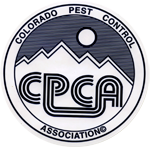Pest Library - Fleas, Mites & Ticks
Pests include those organisms which vector human disease, such as rats and fleas which carry the plague disease, mosquitoes which vector malaria, and ticks which carry Lyme Disease.
Fleas
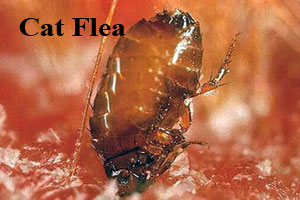
Flea is the common name for insects of the order Siphonaptera which are wingless insects whose mouthparts are adapted for piercing skin and sucking blood. Fleas are external parasites, living by hematophagy off the blood of mammals (including humans) and birds.
In the past, it was most commonly supposed that fleas had evolved from the flies (Diptera), based on similarities of the larvae. (Some authorities use the name Aphaniptera because it is older, but names above family rank need not follow the ICZN rules of priority, so most taxonomists use the more familiar name). Genetic and morphological evidence indicates that they are descendants of the Scorpionfly family Boreidae, which are also flightless; accordingly it is possible that they will eventually be reclassified as a suborder within the Mecoptera. In any case, all these groups seem to represent a clade of closely related insect lineages, for which the names Mecopteroidea and Antliophora have been proposed.
- Some flea species include:
- Cat flea (Ctenocephalides felis)
- Dog flea (Ctenocephalides canis)
- Human flea (Pulex irritans)
- Northern rat flea (Nosopsyllus fasciatus)
- Oriental rat flea (Xenopsylla cheopis)
Relationship with host
Fleas attack a wide variety of warm-blooded vertebrates including dogs, cats, humans, chickens, rabbits, squirrels, rats, ferrets, and mice. Fleas are a nuisance to their hosts, causing an itching sensation which in turn may result in the host attempting to remove the pest by biting, pecking, scratching, etc. the vicinity of the parasite. Fleas are not simply a source of annoyance, however. Some people and animals suffer allergic reactions to flea saliva resulting in rashes. Flea bites generally result in the formation of a slightly-raised swollen itching spot with a single puncture point at the center (similar to a mosquito sting). The bites often appear in clusters or lines of two bites, and can remain itchy and inflamed for up to several weeks afterwards. Fleas can also lead to hair loss as a result of frequent scratching and biting by the animal, and can cause anemia in extreme cases.
Besides the problems posed by the creature itself, fleas can also act as a vector for disease. For example, fleas transmitted the bubonic plague between rodents and humans by carrying Yersinia pestis bacteria. Murine typhus (endemic typhus) fever, and in some cases Hymenolepiasis (tapeworm) can also be transmitted by fleas.
Mites
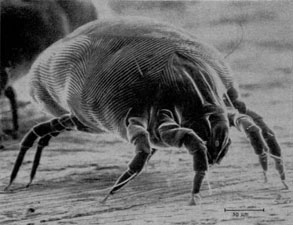
Mites belong to the subclass Acarina (also known as Acari) and the class Arachnida. Mites are among the most diverse and successful of all the invertebrate groups. They have exploited an incredible array of habitats, and because of their small size (most are microscopic) go largely unnoticed. Many live freely in the soil or water, but there are also a large number of species that live as parasites on plants, animals, and some that feed on mold.
Allergy to Mites
Mites cause several forms of allergic diseases, including hay fever, asthma and eczema and are known to aggravate atopic dermatitis. Mites are usually found in warm and humid locations, including beds. It is thought that inhalation of mites during sleep exposes the human body to some antigens that eventually induce hypersensitivity reaction. Dust mite allergens are thought to be among the heaviest dust allergens.
Like most of the other types of allergy, treatment of mite allergy starts with avoidance. There is a strong body of evidence showing that avoidance should be helpful in patients with atopic dermatitis triggered by exposure to mites. Regular washing of mattresses and blankets with hot water can help in this regard. Antihistamines are also useful; Cetirizine, for example, is shown to reduce allergic symptoms of patients. However not all types of mites are infectious including the Alaskozetes antarcticus an arctic inhabiting mite.
Clover Mites
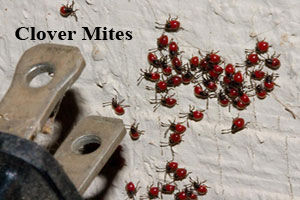
The clover mite, Bryobia praetiosa, is a type of mite best known for the reddish stain left on surfaces after being crushed. Clover mites are 1/30 inch long, oval shaped arachnids with a pair of long legs pointing forward often mistaken for antennae. They are reddish-brown; the younger ones and the eggs are a bright red.
Clover mites can become a nuisance in and around houses. They generally enter houses close to thick vegetation and can infiltrate houses in very large numbers through cracks and small openings around windows and doors. Whether indoors or outside, clover mites are found more commonly in sunny areas than in darker areas.
Spider Mites
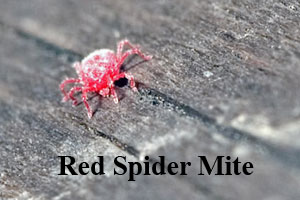
Spider mites are members of the Acari (mite) family Tetranychidae, which includes about 1600 species. They generally live on the under sides of leaves of plants, where they may spin protective silk webs, and they can cause damage by puncturing the plant cells to feed. Spider mites are known to feed on several hundred species of plant.
Spider mites are less than 1 mm in size and vary in color. They lay small, spherical, initially transparent eggs and many species spin silk webbing to help protect the colony from predators; they get the "spider" part of their common name from this webbing. Hot, dry conditions are often associated with population build-up of spider mites. Under optimal conditions (approximately 80ºF), the two-spotted spider mite can hatch in as little as 3 days, and become sexually mature in as little as 5 days. One female can lay up to 20 eggs per day and can live for 2 to 4 weeks, laying hundreds of eggs. A single mature female can spawn a population of a million mites in a month or less. This accelerated reproductive rate allows spider mite populations to adapt quickly to resist pesticides, so chemical control methods can become somewhat ineffectual when the same pesticide is used over a prolonged period.
Ticks

Tick is the common name for the small arachnids in superfamily Ixodoidea that, along with other mites, constitute the Acarina. Ticks are ectoparasites (external parasites), living by hematophagy on the blood of mammals, birds, and occasionally reptiles and amphibians. Ticks are vectors of a number of diseases, including Lyme disease, Q fever, Colorado tick fever, tularemia, tick-borne relapsing fever, babesiosis, ehrlichiosis and Tick-borne meningoencephalitis, as well as anaplasmosis in cattle and canine jaundice.
Ticks are a vector for a number of diseases including Lyme disease, Rocky Mountain spotted fever and other Tick-borne disease.
- Tick Species
- American Dog Tick, Dermacentor variabilis, is perhaps the most well-known of the North American hard ticks. This tick does not carry Lyme disease but can carry Rocky Mountain spotted fever.
- The Deer Tick, Ixodes scapularis, is common to the eastern part of North America and is known for spreading Lyme disease.
- The Western Black-legged Tick, Ixodes pacificus, lives in the western part of North America and is responsible for spreading Lyme disease and Rocky Mountain spotted fever. It tends to prefer livestock such as cows as its adult host.
- The Lone Star Tick, Amblyomma americanum, is part of the Ioxdidae family, classifying it as a hard tick. The adult females are distinguished by a white dot or "lone star" on its back. The adult males can also be seen with dots and white streaks on the edge of their bodies. This tick has been associated with transmission of Southern Tick Associated Rash Illness (STARI) in humans, which is a disease caused by a Borrelia sp. related to the agent that causes Lyme Disease.


